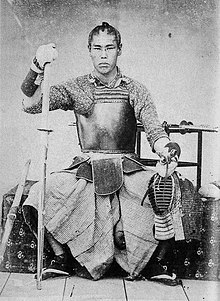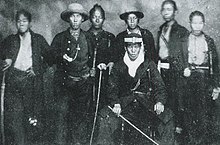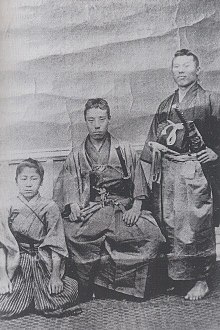| |
高杉 晋作(1839年9月27日-1867年5月17日),讳春风,通称晋作,又名东一、和助,字畅夫,号东行。幕末长州藩士。以创设奇兵队而活跃于倒幕活动而知名。
假名有谷 潜藏、谷 梅之助、备后屋助一郎、三谷和助、祝部太郎、宍戸刑马、西浦松助等。之后改名为谷 潜蔵。赠正四位。
经历
为长门国萩城下菊屋横丁(现在山口县萩市)长州藩士高杉小忠太的长男,生于天保10年8月20日。
十歳时得到疱疮,幸而未死。嘉永5年(1852年)进入藩校的明伦馆并且学习剑术。安政4年(1857年)进入由吉田松阴主持的松下村塾,安政5年(1858年)接受藩命到江户游学并且进入昌平坂学问所学习。安政6年(1859年),松阴因为安政大狱被捕而被处死刑。万延元年(1860年)11月回乡,与被称为防长第一美人的山口町奉行井上平右卫门次女雅(まさ)结婚。
文久元年(1861年)3月为了训练海军,于是搭乘藩里所拥有的军舰丙辰丸前往江户。8月前往东北游学,和佐久间象山及横井小楠等人结为好友。文久2年(1862年)5月受到藩命和五代友厚一起作为幕府使节随行人员从长崎远航到上海、当时的上海正逐渐成为英国和法国的殖民地和租界、然后晋作在见识到1854年的太平天国之乱后,7月回国,因此他的日记‘游清五录’被认为受到此些历史事件很大的影响。
高杉远航时,守旧派的长井雅乐失势,尊攘派开始抬头,高杉也和桂小五郎及久坂义助等人一起加入尊攘运动,于江户和京都展开勤皇及破约攘夷的宣传活动,并且和各藩的志士们互相交流。在这过程中,高杉和长州的志士们逐渐形成长州民族主义,而长州藩和朝廷及他藩的谈判工作就由桂和久坂专门负责。文久2年(1862年)12月12日,为了抗议幕府的异敕,高杉与同志一起烧毁在品川御殿山里建设中的英国驻日公使馆,然后把吉田松阴的遗骨从小冢原刑场迁葬到世田谷。
文久3年(1863年)5月10日,由于幕府从朝廷方面要求停止攘夷的期限已过,于是长州藩对在关门海峡外国船只进行炮击,高杉受委托担任下关的防卫工作,但反而遭到美法两国的报复攻击而惨败(下关战争)。6月在回船批发商白石正一郎的家中组成不依据身份安排职位的奇兵队,并且以阿弥陀寺(现赤间神宫)为根据地(但在9月的教法寺事件被罢免总监职位)。
在京都由于萨摩藩和会津藩勾结,于是对在宫廷造成“八月十八日政变”的长州藩进行放逐。文久4年(1864年)1月,高杉想要说服主张进军京都的激进派来岛又兵卫却被其拒绝,于是高杉脱藩并且前往京都潜伏着。之后由于桂小五郎的说服而在二月归乡,但因为脱藩罪而被关到野山狱中,六月出狱并且遭到观察的处分。7月,长州藩在禁门之变战败而成为朝敌,来岛及久坂玄瑞战死和自杀。8月时,英国、法国、美国、荷兰所组成的四国联合舰队向下关炮撃并且占领炮台,于是晋作遭到赦免而担任和谈的工作。
这次的和谈,英国提了许多条件并且要求‘租借彦岛’。高杉大体上接受全部的条件,但对于‘租借领土’的条件则是坚决不答应,结果是成功地让那些国家撤销租借领土的主张。或许是在中国见识到清朝遭遇的高杉深深看透‘领土附期限租借’的意义而拒绝。伊藤博文后于其自传忆述,如果高杉那时接受条件,将会大大改变日本历史,而这时的高杉晋作仅仅24歳。
由于在幕府第一次长州征伐的逼迫下,长州藩的俗论派(佐幕派)抬头。10月,高杉逃往福冈,在躲藏于平尾山庄时,听到属于俗论派的正义派家老遭处刑的事情,于是再次回去下关。12月15日的半夜,由伊藤俊辅率领的力士队、石川小五郎率领的游撃队和其他长州藩诸队在功山寺举兵,之后奇兵队加入这些起义队伍。元治2年(1865年)3月,排斥俗论派的首领椋梨藤太掌握了藩的实权。同月,高杉企图前往长崎和英国商人Glover接触但遭到反对。4月时,由于下关开港的事件,而成为攘夷派和俗论派的目标,因此高杉和爱妾鹈野(おうの)一起逃往四国投靠日柳燕石。6月时,经由桂小五郎的斡旋而得以归乡。
庆应元年(1865年)1月11日,晋作遭废嫡,在同年9月29日受藩命改名为谷 潜藏。庆应3年(1867年)3月29日时,被赐与新知100石,成为创立谷家的初代当家。
庆应2年(1866年)1月21日(有一说是1月22日),在土佐藩的坂本龙马、中冈慎太郎、土方久元的中介下,晋作和桂小五郎、井上闻多、伊藤俊辅一起在京都和萨摩藩组成萨长同盟。
5月时,与伊藤俊辅一起被命令前往萨摩,并且在长崎单独买下了丙寅丸。
在6月的第二次长州征伐担任海军总督并击退幕府舰队,夺回了周防大岛。而在小仓方面,于序盘攻势时与肥后藩在小仓城的战斗势均力敌,使得长州藩的局势一度呈现好转的状态。
由于幕府军总督小笠原长行胆小寡断而激怒了加入幕府军的诸藩们,他们威胁随时要撤兵。7月时则因为收到将军德川家茂死去的消息,使得小笠原决定撤退,此事因此决定了幕府的败战。这次的败战使得幕府的权威大大的坠落,成为庆应3年(1867年)11月大政奉还的巨大转捩点,但是晋作自己却在此时患了肺结核,于是不得不在樱山展开疗养生活。同年的5月17日(庆应3年4月14日),还未见到大政奉还的高杉过世,得年27岁。临终时有父母和妻儿在身旁陪他,并且据说野村望东尼和山县狂介、田中显助等人也在高杉临死前和他见过面,但根据田中残余的日记来看,他那时人正在京都,所以详情不明。高杉之墓位于现在的山口县下关市。
后来因为木户孝允和大村益次郎等人的要求,于是高杉和吉田松阴、久坂玄瑞、坂本龙马及中冈慎太郎等人,一起被迎接进入现在的靖国神社受到表彰和祭拜。
高杉的辞世之句为“面白き 事も無き世を 面白く”(让这无趣的世界变得有趣吧)。
在他的彰显碑上写着:“动如雷电、发如风雨、众目骇然、无敢正视者、此非我东行高杉君哉。” 这是伊藤博文对高杉晋作所作的评价。
登场作品
- 小说
- 栖世之日(文艺春秋、司马辽太郎著)
- 第十一位志士(文艺春秋、司马辽太郎著)
- 高杉晋作(讲谈社、山冈庄八著)
- 高杉晋作(学研、三好彻著)
- 晋作 苍蓝烈日(NHK出版、秋山香乃著)
- 高杉晋作(讲谈社、池宫彰一郎著)
- 青年(中央公论新社、林房雄著)
- 高杉晋作奔突(讲谈社、古川薰著)
- 高杉晋作~战斗者的爱与死~(新潮社、古川薰著)
- My Dear Shinsaku(新潮社、今江祥智著)
- 影视剧
- 决战奇兵队(1941年、日活、演:岚寛寿郎)
- 风云千两船(1952年、东宝、演:长谷川一夫)
- 幕末太阳传(1957年、日活、演:石原裕次郎)
- 高杉晋作(1963年、ANB、演:宗方胜巳)
- 幕末(1964年、TBS、演:木村功)
- 三姊妹(1967年、NHK大河剧、演:山本学)
- 少年高杉晋作(1967年、NET、演:加藤刚)
- 第十一位志士(1968年、NET、演:平干二朗)
- 龙马来了(1968年、NHK大河剧、演:和田浩治)
- 吉田松阴(1969年、KTV、演:高桥长英)
- 天皇的世纪(1971年、ABC、演:原田大二郎)
- 清水次郎长(1971年、CX、演:古谷一行)
- 花神(1977年、NHK大河剧、演:中村雅俊)
- 风在燃烧(1978年、TBS、演:山口崇)
- 幕末青春涂鸦:坂本龙马(1982年、NTV、演:吉田拓郎)
- 龙马来了(1982年、TX、演:田村亮)
- 大奥(1983年、KTV、演:大桥吾郎)
- 服部半藏 影之军团(1985年、KTV、演:本田博太郎)
- 奇兵队(1989年、NTV、演:松平健)
- 坂本龙马(1989年、TBS、演:井上纯一)
- 野心之国(1989年、NTV、演:阵内孝则)
- 宛如炎光 吉田松阴(1991年、KRY、演:中西良太)
- 拜托龙马了!(1996年、NTV、演:寺胁康文)
- 龙马来了(1997年、TBS、演:西村和彦)
- 尾张幕末风云录(1998年、TX、演:篠冢胜)
- 苍天之梦(2000年、NHK、演:野村万斋)
- 龙马来了(2004年、TX、演:葛山信吾)
- 长州五杰(2006年、Libero、演:寺岛进)
- 狱中花开(2010年、Thanks Lab、演:南誉士广)
- 龙马传(2010年、NHK大河剧、演:伊势谷友介)
- 鲜为人知的幕末志士:山田显义物语(2012年、MBS、演:桐山照史)
- 花燃(2015年、NHK大河剧、演:高良健吾)
- 舞台
- 歌谣
- 漫画
- 跑吧晋作(角川书店、桥本光男作)
- 夕凪(角川书店、杉本亚未作)
- 萩生养的少年志士:吉田松阴与其门下生(齐藤荣一作)
- 喂!龙马(小学馆、武田铁矢作・小山由画)
- SIDOOH 士道(集英社、高桥努作)
- 仁者侠医(集英社、村上纪香作)
- 神剑闯江湖(集英社、和月伸宏作)
- 银魂(集英社、空知英秋作)
- 无敌怪医K(讲谈社、真船一雄作)
- 龙马へ(讲谈社、陆奥利之作)
- 爆弹!〜幕末男子〜(讲谈社、加濑敦作)
- 魔女三百才开始(白泉社、原田重光作・松本救助画)
- 游戏
- 明治维新
- 维新之岚
- 维新之岚:幕末志士传
- 坂本龙马・维新开国
- 风云:幕末传
- 遥远时空
- 里语 薄樱鬼
- 在茜色天空与君咏唱
- 幕末ROCK
Takasugi Shinsaku (高杉 晋作, 27 September 1839 – 17 May 1867) was a samurai from the Chōshū Domain of Japan who contributed significantly to the Meiji Restoration. He used several alias to hide his activities from the Tokugawa shogunate.
Early life
Takasugi Shinsaku was born in the castle town Hagi, the capital of the Chōshū Domain (present-day Yamaguchi Prefecture) as the first son of Takasugi Kochuta, a middle-ranked samurai of the domain and his mother Michi (道). He would have three younger sisters by the name of Tomo (智), Sachi (幸) and Mei (明). He had smallpox at the age of ten, but fortunately he had recovered from it.
Takasugi joined the Shoka Sonjuku, the famous private school of Yoshida Shōin. Takasugi devoted himself to the modernization of Chōshū's military, and became a favorite student of Yoshida. In 1858, he entered the Shōheikō (a military school under direct control of the shōgun at Edo). When his teacher was arrested during the Ansei Purge in 1859, Takasugi visited him in jail. Shōin was later executed in 21 November 1859. In December 1859 he returned home by the clan's command.
In January 1860, Takasugi married Inoue Masa, the second daughter of Yamaguchi retainer and magistrate Inoue Heiemon who was also the friend of his father. Masa was said to be the most beautiful lady in Suō and Nagato provinces. Their marriage was arranged by his parents, with hope that he would take his mind off of his teacher's death in 1859 and to settle down with his new bride.
However, in April 1861, Takasugi would left his home and undertook naval training on the clan's warship Heishinmaru, and travelled to Edo. Later in September he went to study at the Tōhoku region, and there he was associated with Sakuma Shōzan and Yokoi Shōnan.
Foreign experience
Takasugi, in spite of his young age, was an influential factor within Chōshū as one of the most extreme advocates of a policy of seclusion and expelling the foreigners from Japan. Takasugi was implicated in the 31 january 1863 attack on the British legation in Edo.
In spite of Japan's policy of national isolation in the Edo period, in 1862 Takasugi was ordered by the domain to go secretly to Shanghai in China to investigate the state of affairs and the strength of the Western powers. Takasugi's visit coincided with the Taiping Rebellion, and he was shocked by the effects of European imperialism even on the Chinese Empire. Takasugi returned to Japan convinced that Japan must strengthen itself to avoid being colonized by the western powers, or to suffer a similar fate as China. This coincided with the growing Sonnō Jōi ('expel the barbarians and revere the Emperor') movement, which attracted certain radical sections of Japan's warrior class and court nobility, and Takasugi's ideas found ready support in Chōshū and other parts of Japan.
Formation of the Shotai and Kiheitai
Takasugi originated the revolutionary idea of auxiliary irregular militia (shotai). Under the feudal system, only the samurai class was allowed to own weapons. Takasugi promoted the recruitment of commoners into new, socially-mixed paramilitary units. In these units, neither recruitment nor promotion depended (at least in theory), on social status. Farmers, merchants, carpenters and even sumo-wrestlers and Buddhist priests were enlisted, although samurai still formed the majority in most of the Shotai. Takasugi clearly saw that utilization of the financial wealth of the middle-class merchants and farmers could increase the military strength of the domain, without weakening its finances. Since the leaders of Chōshū were unable - and unwilling - to change the social structure of the domain, limited use of peasants and commoners enabled them to form a new type of military without disturbing the traditional society.
In 1863, Takasugi himself founded a special Shotai unit under his direct command called the Kiheitai, which consisted of 300 soldiers (about half of whom were samurai). However, due to his propagation of Sonnō Jōi ideology, Takasugi was imprisoned by the domain's authorities, after an anti-Chōshū coup in Kyoto in the summer of 1863 threatened to jeopardize Chōshū's leading role in national politics.
External and internal crisis
However, Chōshū soon had no choice but to call on Takasugi again. After Chōshū fired upon Western warships in the Straits of Shimonoseki on 25 June 1863, British, French, Dutch and American naval forces bombarded Shimonoseki, the main port of the Chōshū domain the following summer in what was later called the Bombardment of Shimonoseki. This was followed by the landing of French marines. Their fighting against Chōshū units demonstrated the inferiority of traditional Japanese troops against a Western army, and convinced the leaders of the domain of the absolute necessity for a thorough military reform. The Chōshū domain's administration called on Takasugi not only to carry out this reform as ‘Director of Military Affairs’, but he - only 25 years of age - was also entrusted with negotiating peace with the four Western powers.
In view of the humiliation of Chōshū forces against the Western powers, Takasugi had come to the realization that direct confrontation with the foreigners was not an option. Instead, Japan had to learn military tactics, techniques and technologies from the West. Takasugi reorganized his Kiheitai militia into a rifle-unit with the latest modern rifles, and introduced training in Western strategy and tactics. Moreover, Takasugi used his influence with the Sonnô Jôi-movement to promote a more a conciliatory policy towards the West and thus, the ‘movement to expel the barbarians and revere the Emperor’ evolved into an anti-Bakufu movement with the overthrow of the Tokugawa Bakufu as a necessary means to strengthen Japan against the foreigners.
Weakened by the punitive attack by the Western powers, Chōshū was unable to withstand an expedition mounted by the Bakufu in autumn 1864 in retaliation for previous Chōshū attempts to seize control of Kyoto. At first, conservative forces, which favored conciliation with the Bakufu in order to secure the domain, were dominant in Chōshū politics, and Takasugi and some of his compatriots had to leave the domain to avoid renewed imprisonment. Takasugi, with only about a dozen followers, including future political leaders Yamagata Aritomo, Itō Hirobumi and Inoue Kaoru, gathered in Kokura in Kyūshū and prepared an attack on the conservative forces in Chōshū. The subsequent Chōshū civil war began on 13 January 1865.
Takasugi played a major role in this civil war and his Kiheitai militia proved its superiority over old-fashioned samurai forces. With a series of quick strikes and the support of Katsura Kogorō, Takasugi achieved victory by March 1865. He became one of the main arbiters of the Chōshū domain's policy and continued to act as the domain's expert on Western military science, devoting his efforts to importing arms and raising troops. These reforms proved to be successful when Chōshū was victorious on four fronts against the Bakufu's Second Chōshū expedition in 1866, with the Kiheitai itself securing victory on two fronts. Takasugi's efforts had made a small-scale ‘nation in arms’ out of Chōshū, giving it a military strength out of proportion to its relatively small size. With its victory over the Tokugawa forces, the military power of the Bakufu was discredited, and traditionally rival domains decided to join forces with Chōshū in the subsequent battles which led to the Meiji Restoration and the end of the Tokugawa Bakufu.
Death
Takasugi did not live to see this success. He died of tuberculosis in the residence of the bar manager Hayashi Sankuro at Shimonoseki on 17 May 1867, while under the care of his former mistress O-Uno and his wife Masa. His Kiheitai was taken over by his protégé Yamagata Aritomo. Only a year later, Takasugi's dream of overthrowing the Tokugawa Shogunate, which found obvious manifestation in his alternate name Tōgyō (Go to the East) - was fulfilled with the Meiji Restoration.
The Kiheitai was disbanded in 1868, the success of the socially mixed unit and its Western armaments and tactics was an important influence on the development of the Imperial Japanese Army, and on the later system of universal military conscription in Japan.
Legacy
Takasugi Shinsaku, a central figure of the early Meiji Restoration, is as well known for his military talents as he is for his skills as a politician. However, dying at the young age of 28, Takasugi was not to become one of Japan's famous leaders in the subsequent Meiji era. In his hometown - the castle town Hagi, Yamaguchi in south-western Japan - he is still remembered as a mystical and energetic hero, who put all his efforts into opening the way to modernization, westernization and reforms, not only in military matters but in political and social matters as well.
Court rank
- Shoshi’i (正四位, Senior Fourth Rank)
Gallery of birthplace of Takasugi Shinsaku
Takasugi Shinsaku in media
- Takasugi is a secondary character present in the manga and anime Rurouni Kenshin, as well as its OAV adaptation Trust and Betrayal, shown to be in the last stages of his illness. He recruited the young Himura Kenshin into the Kiheitai before allowing Chōshū leader Katsura Kogorō to make him the Hitokiri Battōsai. While portrayed as a brash and ruthless warrior, he is nonetheless wary of his unsavory actions and tried to dissuade Katsura from "corrupting" Kenshin's soul, to no avail. His Japanese voice actor is Wataru Takagi, and his English voice actor is Jason Phelps.
- Takasugi was the inspiration for Takasugi Shinsuke, one of the main and earliest antagonists in the manga series Gin Tama.
- A highly fictionalized version of Takasugi appears in the PSP game Bakumatsu Rock and its anime adaptation. In the game, which is set in the Bakumatsu and has a musical theme, he is depicted as the bass player in a rock band led by Sakamoto Ryōma.
- Takasugi Shinsaku is usually portrayed in most NHK Taiga drama dealing with the Meiji Restoration. Most recent instances would be:
- Ryōmaden, played by Japanese actor Yusuke Iseya
- Hana Moyu, played by Japanese actor Kengo Kora.
- Takasugi Shinsaku was played by Japanese actor Yujiro Ishihara in the 1957 film Sun in the Last Days of the Shogunate.
- Takasugi Shinsaku is credited with the aphorism "Live a pleasant life in the unpleasant world" in the manga Natsuyuki Rendezvous.
- Takasugi Shinsaku is the protagonist in the anime "Bakumatsu".His Japanese voice actor is Nakamura Yuuichi.
Notes
- ^ "The Togyoan Hermitage & Memorial Museum (gravesite of Takasugi Shinsaku)(Yamaguchi) | JAPAN TIMELINE ~See what is happening in Japan now~". JAPAN TIMELINE. Retrieved 2018-07-19.
















